This is an Olympus XA2 scale focus point and shoot 35mm camera made by Olympus Optical Co., Ltd. between the years of 1980 and 1986. It was a simpler and less expensive version of the Olympus XA camera released a year earlier. The entire XA series was very innovative, including many firsts in the point and shoot camera segment. They were a huge success for Olympus and are still popular with collectors today due to their small size, ease of use, and excellent optics.
Film Type: 135 (35mm)
Lens: 35mm f/3.5 Olympus D.Zuiko coated 4-elements
Focus: 3.3 feet to Infinity in 3 zones (Portrait, Group, and Landscape)
Viewfinder: Scale Focus with 35mm Projected Brightlines
Shutter: Leaf
Speeds: 2 – 1/750 seconds
Exposure Meter: Coupled CdS Cell with Programmed Auto Exposure
Battery: 2x SR44 / LR44 / A76 / 357 1.5v Batteries
Flash Mount: External Coupling for Olympus A11 or A16 Flash
Weight: 200 grams
Manual: http://www.cameramanuals.org/olympus_pdf/olympus_xa2.pdf
History
Ask a group of camera collectors to name their favorite plastic point and shoot camera, and I’d bet that at least half would all mention one model from the Olympus XA series, specifically the original XA model (not to be confused with a later, less featured XA1).
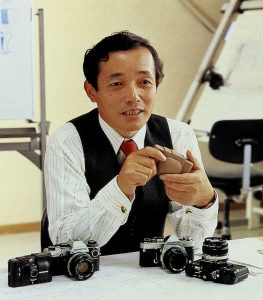
The original Olympus XA made it’s public debut at the 1978 Photokina and went on sale in May of 1979. It was a revolutionary new camera built inside of a clam shell case that kept it’s size to a minimum, but offered specs that compared favorably to much larger SLRs of the day. Designed by Olympus’s chief designer Maitani Yoshihisa who was also responsible for the original half frame Olympus Pen, the Pen F SLR, and the OM-1 SLR, the Olympus XA had a high spec 6-element f/2.8 F.Zuiko lens, a coupled rangefinder that could focus as close as 85cm, aperture priority auto exposure via twin CdS meters, and a shutter capable of speeds as fast as 1/500 of a second.
Maitani and his team spent months coming up with the shape and design of the camera. The shape of the camera was derived from a clay model that Maitani had worked on in his free time. When the overall size and shape of the camera was realized, a new challenge arose to fit everything in the camera. There were no lens formulas at the time that could be shrunk down to fit in the necessary space while still achieving the full 35mm frame coverage and quality that Olympus had demanded. As a result, a “reversed retrofocus” formula adapted from existing telephoto lenses was used to create a 6-element lens that was only 31mm from front element to film plane.
Challenges arose in the shutter mechanism requiring a new type of rare earth magnet to actuate the shutter at it’s desired top 1/500th speed. In order to avoid camera shake, the shutter had to be very sensitive, while still being reliable and precise so Maitani consulted a variety of specialized manufacturers to come up with a special pressure sensitive conductor to met all of his requirements.
Even the rangefinder had to be designed from the ground up as it required an extremely short base to fit within the case while still being accurate. The rangefinder on the XA has the shortest base of any rangefinder ever made, yet it still does an excellent job at measuring distance correctly.
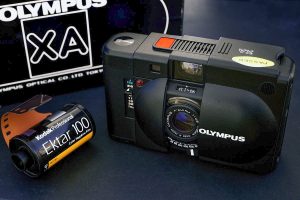
The XA was the most advanced compact camera in the world upon it’s release and quickly became popular as a backup camera to professional photographers and anyone who needed a compact camera but was unwilling to sacrifice quality. One way in which the entire XA series was able to maintain such a small size was the lack of a built in flash. If you needed flash photography, the camera had an optional flash attachment that would connect to the side and upon it’s connection, would allow you to put the camera into flash mode with a fixed shutter speed.
For all the praise that can be heaped upon the XA, it came at a cost. Selling for around $200 in July 1979 which when adjusted for inflation is about $625 today, the camera was not cheap and likely didn’t sell well beyond a very specific target customer.
As a result, a year after it’s introduction, Olympus would release the XA2 which kept the same basic design, but came with a simpler 4-element f/3.5 F.Zuiko lens and lost the rangefinder. The XA2 was a scale focus camera that allowed the photographer to choose one of three focus zones for portrait, group, and landscape shots. The only other setting available on the XA2 was the manual ASA film speed selector, but everything else was handled by the camera’s fully programmed auto exposure system. I could not find any list prices for the XA2 from the era, but various price catalogs where both the XA and XA2 were listed consistently show the XA2 at a 25% discount compared to the XA, suggesting it had a list price of somewhere around $150.
The XA2 was the most popular of the XA series and was sold for nearly 6 years. In 1985, two new models called the XA3 and XA4 were released which refreshed the XA2’s specs offering DX encoding capabilities, a +1.5EV backlight switch, and in the XA4 a 28mm wide angle lens with macro capability.
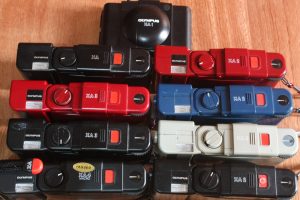
The XA-series remained in production until the early 1990s when they were replaced by the compact mju series, which for a high spec manual focus camera was pretty impressive for the time when point and shoot cameras were increasingly automatic.
Today, the entire XA series is held in high regard by collectors, specifically the original XA model for it’s unique feature set. A search of sold prices on eBay for the original XA model well exceed $100 in working condition, and even “as-is” models generally fall into the $50 – $75 range making them one of the more expensive point and shoots out there. The XA2 was the most common and is the most affordable in the range today. The XA3 and 4 models can sometimes fetch higher prices simply due to rarity. If you have an opportunity to buy an XA model, regardless of which one, it’s worth a second look as these aren’t just another cheap $1 garage sale camera.
My Thoughts
I have come across two different XA2s and the first had a dead meter which I have discovered to be a common problem with these cameras. Although the camera will still fire the shutter with a dead meter, since it couldn’t detect any amount of light, it would always fire the shutter at the slowest speed of 2 seconds. Another side effect is that the green slow shutter speed indicator lamp in the viewfinder would always remain lit. If you run into an XA2 that only fires it’s shutter at the slowest speed and this light always remains on, then you know that either the meter is dead, or isn’t getting any power from the battery. Sadly, I don’t have any suggestions on how to fix this and I wasn’t willing to venture into the camera, so I just waited until I found another.
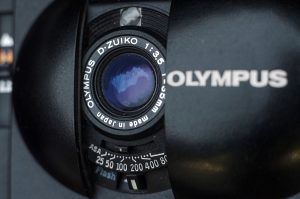
Once I got a working XA2, I was excited to be able to see what all the fuss was about. While the original Olympus XA is the most desirable of the series with it’s rangefinder, better lens, and ability to manually control the aperture, there are quite a few people who prefer the XA2 over the XA. I’ve read comments that the XA2’s meter is more reliable and the simpler 4-element f/3.5 lens in the XA2 gives better coverage than the 6-element in the XA. Other comments suggest that although the XA has a rangefinder for precise focus, the faster zone focus of the XA2 takes better advantage of the camera’s wide depth of field, allowing a photographer to more quickly get accurate focus without having to mess with a rangefinder. Since I don’t actually own an XA, I can only speculate that these comments are valid, but even if they are not, I’ll at least say the XA2 is still a very good camera.
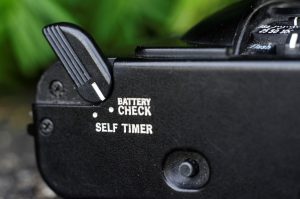
Despite the impressive technology behind the XA2, it has very few controls. The camera is fully automatic and only offers programmed auto exposure with no manual override. It was designed to be very easy to use with as little input from the user as absolutely necessary. In fact, other than the shutter release and the 3-zone focus lever, the only other controls on the camera are the manual selector for film speed (from ASA 25 – 800), the self-timer lever on the bottom of the camera which also doubles as the battery check switch, and the flash activation lever which only works with a flash attached to the camera.
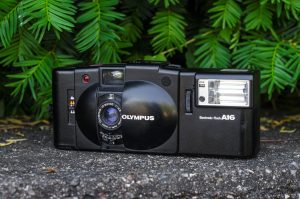
Sold with the XA2 series were a few different flashes, the A11 is the most common, but there was also the A16 which had a more powerful flash. The flash would attach to the side of the camera using a proprietary threaded hole, and once connected would allow you to move the little flash lever below the lens to enable ‘flash mode’. Putting the camera into flash mode deactivates the auto exposure of the camera and sets the shutter to a fixed 1/30 speed. The users manual for the XA2 warns against setting the camera to the landscape (mountain) focus setting as objects will be outside of the usable range of the flash. For properly illuminated flash photography, you need to keep the camera at the close focus or the middle focus settings. I am not 100% sure of this, but my guess is that at these two focus settings, the camera changes the size of the iris to let less light in at close focus and more at the middle focus setting.
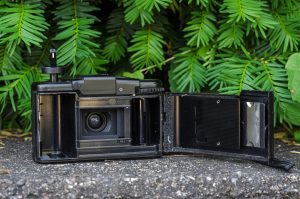
Loading film into the camera requires the front clam shell to be shut in order to pull up on the rewind knob which doubles as the door release. When I received this XA2, it’s light seals were crumbling so they needed to be replaced. Otherwise, what you are presented with is a rather ordinary film compartment. A new cassette goes on the left and you thread the leader into one of the multiple slits in the take up spool. The very short path for the leader to travel across the film gate and onto the takeup spool means that you waste less film at the beginning and end of a roll allowing you to get an extra exposure or two on a roll of film.
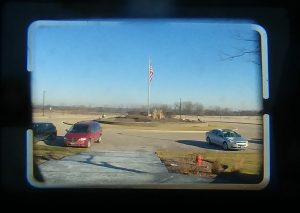
The viewfinder for the XA2 is typical for the point and shoot segment of the late 1970s and early 80s, which is to say that its still usable with prescription glasses, but not as big as a typical SLR viewfinder would have been around that same time. The XA2’s viewfinder is bare bones, only showing a flash indicator and a slow shutter speed warning light but that is all. There is no indicator of the camera’s chosen shutter speed, aperture, or even which focus distance is being used.
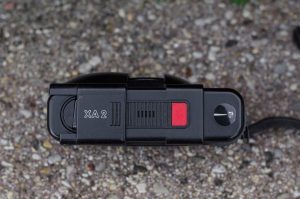
When the original XA was designed, Maitani Yoshihisa designed a very sensitive shutter release that required very little pressure to activate. The thought behind this was that he could minimize camera shake by eliminating a long travel of the shutter release button. In theory, this accomplishes that task as the shutter release is very easy to fire, but it also has the side effect of increasing the chances of unintentional exposures, a complaint that many reviews of these cameras have pointed out. This sensitive shutter release would be carried over to the rest of the series, including the XA2. As a result, it is highly advisable to close the dust cap, covering the lens and thus disabling the shutter when the camera is not in use.
Shooting the XA2 is a mostly forgettable experience, but that was kind of the point. A unique aspect to shooting the camera is that it’s simplicity and fully automatic control, yet still being a manual focus camera puts it in a very small selection of cameras. I am no stranger to point and shoot cameras from the 1970s and 80s, but most of these also included auto focus, something the entire XA series lacks. It is very easy to put this thing to your eye and forget to focus it. Thankfully, the 3 zone system has a wide depth of field and the fact that the camera always reset itself to the ‘middle focus’ setting each time you close and reopen the camera, this doesn’t prove to be as big of a problem as you might expect.
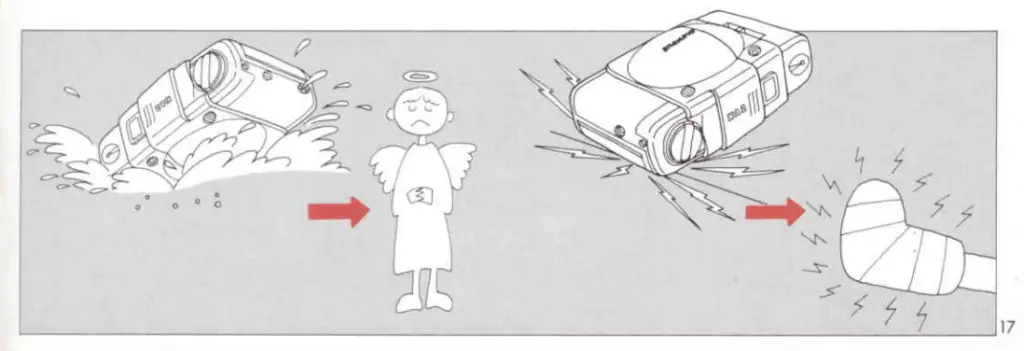
The manual for the XA2 was clearly designed for the novice photographer, giving instructions on it’s use with very few words and many illustrations. Some of the illustrations are hilariously bad, such as the warnings on page 17 which suggest if the camera gets wet, a frowny face angel may come visit you, or if lighting bolts shoot out of the side of the camera, you may experience more lightning bolts if you also have a cast on your leg. Why they couldn’t just say “Don’t get the camera wet or drop it.” is anyone’s guess.
The strong preference for illustrations was probably a good idea for the target customer that the XA2 was likely sold to, but trying to glean some technical information, especially about the exposure or focusing systems is incredibly difficult.
It would be impossible to know the exact depth of field offered at each of the camera’s three zone focus settings as you would also need to know the camera’s programmed combination of shutter speed and f/stops used in each lighting situation, but as best as I can tell from what little technical information there is in the manual, a depth of field range of 4 feet to infinity can be achieved with the focus setting in the middle position on a bright and sunny day. This is great because if you forget to change the focus setting after opening the camera, this is the default setting and one that should get anything you need in focus in ideal lighting.
We know the actual focus distances of the XA2’s three focus settings to be: (An alternate version of the XA2’s manual found here states the actual focus distance for all 3 settings.)
- Close (2 heads) – 4 feet
- Middle (2 torsos) – 8.9 feet
- Far (mountain) – Infinity
The table below offers what I believe are the depth of field ranges of the camera in all 3 zones, and in 3 different lighting situations (indoors, cloudy, and sunny) based on the following assumptions:
- In poor lighting, the camera will open the iris up to f/3.5 and continually drop the shutter speed to compensate, eventually giving a camera shake warning at speeds slower than 1/30.
- In cloudy lighting, the camera will attempt to maximize depth of field by offering a slower shutter speed with a smaller iris probably in the range of f/5.6 – f/8.
- In bright sunlight, the camera uses the smallest f/stop possible which is probably f/16, since that is what is required to get a depth of field of about 4 feet to infinity at a focus distance of 8.9 feet as suggested by the manual.
 Looking at the table to the left, the Close focus doesn’t match my calculations using a Depth of Field calculator. According to this Depth of Field simulator, a 35mm lens at f/3.5 shooting something 4 feet away should have a depth of field of 3.6 ft to 4.4 ft, which doesn’t match the manual’s claim of 3.3 ft to 5 feet. In order for a 35mm lens to have a 3.3 ft to 5 foot depth of field range at 4 feet, the lens would need to be set to f/7.1 which doesn’t make sense to use indoors.
Looking at the table to the left, the Close focus doesn’t match my calculations using a Depth of Field calculator. According to this Depth of Field simulator, a 35mm lens at f/3.5 shooting something 4 feet away should have a depth of field of 3.6 ft to 4.4 ft, which doesn’t match the manual’s claim of 3.3 ft to 5 feet. In order for a 35mm lens to have a 3.3 ft to 5 foot depth of field range at 4 feet, the lens would need to be set to f/7.1 which doesn’t make sense to use indoors.
I’ll stop right there and say that I am way over thinking this. The Olympus XA2 was meant to be easy to use, and analyzing these tables isn’t really necessary. In an effort to get this review back on track and come up with two general guidelines that seem to be true, I’ll make these two recommendations:
- Don’t attempt to use the Close focus setting without a flash, or unless you are shooting in bright outdoor light.
- For general outdoor photography, as long as you have good light, both the Middle and Far settings offer you a nearly focus free experience. Don’t overthink it.
Once you understand that the zone focus method employed by the XA2 isn’t meant to be complicated, you can end up shooting with it faster than someone else using the rangefinder on an XA. That’s not to say that you couldn’t still benefit from a rangefinder, just that the zone focus method isn’t the handicap some people make it out to be.
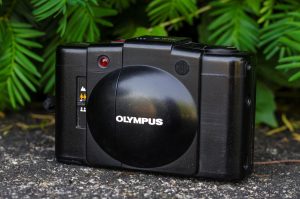
I think therein lies the greatest asset of the XA2 making it one of the most unique cameras ever made. It is an incredibly small and compact full frame 35mm camera that has an excellent lens and metering system allowing you to get near SLR-like images. The simplicity of the zone focus method makes it more predictable than any auto focus system could ever be, and faster than any rangefinder. You could fire off 3 shots using zone focus in the time it takes the average person to stare at a rangefinder patch, trying to find a suitable vertical line to determine the exact correct focus distance and then take one shot.
Overall, the Olympus XA2 is an outstanding camera whose best benefits only reveal themselves after using it. I will admit to being skeptical the first time I picked one up. I completely understand the appeal of a fully automatic everything point and shoot camera, and I understand the benefits of a fully manual camera, but this XA2 with it’s almost fully automatic experience, combined with a 3 zone manual focus system took me a while to appreciate.
After coming to grips with how this camera should be used and embracing it’s “lack” of certain features as a pro, rather than a con, I loaded in a roll of Fuji 200 speed film and kept it in my car for some random everyday pictures in the fall of 2017.
My Results
The Olympus XA2 is designed to be extremely portable and fast to use, which makes it a perfect “every day” camera, so that was my thought process when I took it with me over about a week in the fall 2017 to shoot it as a daily snapshot camera.
It can sometimes be hard to review a camera that is as well documented as the XA2. There were a ton of them made, and they’ve remained popular for their portability and excellent optics for decades after their release in the very early 1980s.
Looking at the images above, I can wholeheartedly agree with pretty much everything I’ve read about the camera. Yes its portable, yes the lens is sharp, yes the metering system works well, and yes the zone focusing system is fast and easy to use. Most importantly, these cameras aren’t that expensive. Compared to the original XA which can fetch well over $100 in working condition, I see XA2s in the $20 – $30 range quite often on eBay.
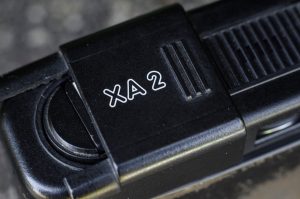
If you were in the market for an XA but didn’t want to spend a lot of money, should you consider the XA2? Absolutely! In my time shooting the XA2, I never once thought that had I had a rangefinder, I could focus easier. In fact, the three focus zones and huge depth of field meant that I rarely had to think about focusing at all. When I had my film developed and scanned in the negatives, I never once thought, “Gee, these images would have looked better with 2 more elements in the lens.”
The XA is a great camera for sure. It’s historically significant, was designed by one of the best camera designers ever to exist, and pioneered several new features that would be common across the industry soon after it’s release. The differences between the XA and XA2 seem drastic on paper, but with the “lesser model” you get the same compact size, the same excellent build quality, the same quality meter, an excellent 4-element lens, and a simplified focusing system that in many situations is actually faster than using a rangefinder. The XA2 represented a hell of a value not only when it was first introduced, but today as well.
So yeah, if you’re in the market for a compact, and easy to use point and shoot, but don’t want the fuss (and noise) of early auto focus systems, the XA2 should be on your radar.
My Final WordHow these ratings work |
The Olympus XA2 is a camera whose reputation precedes itself. This is a very well known and very highly regarded camera for a reason. Perhaps the best characteristic of the camera is that it offers some of the simplicity of a 1980s point and shoot camera, in a very small package, with an excellent lens and meter, but with the control and speed of a manual focus camera. I’ll admit to not “getting” the appeal of this camera until I actually used it, but once I got it, I got it. The results from this camera speak for themselves. The XA2 is a popular camera for a reason. If you are on the fence about whether you should get one, just do it. They sell for considerably less than an XA and if you’re anything like me, once you actually have it in your hands, it will reveal itself to you as a truly special camera. | ||||||
| Images | Handling | Features | Viewfinder | Feel & Beauty | History | Age | |
| 2 | 2 | 1 | 1 | 2 | 1 | 0% | |
| Bonus | +1 for overall excellence, the complete package | ||||||
| Final Score | 10.0 | ||||||
Additional Resources
http://camera-wiki.org/wiki/Olympus_XA
http://www.diaxa.com/xastart.htm
http://www.urban75.org/photos/olympus-xa.html
http://www.theothermartintaylor.com/moveabletype/archives/cameras/000006.html
http://www.photoethnography.com/ClassicCameras/OlympusXA.html
https://web.archive.org/web/20040714094445/http://www.geocities.com/maitani_fan/xa_camera.html

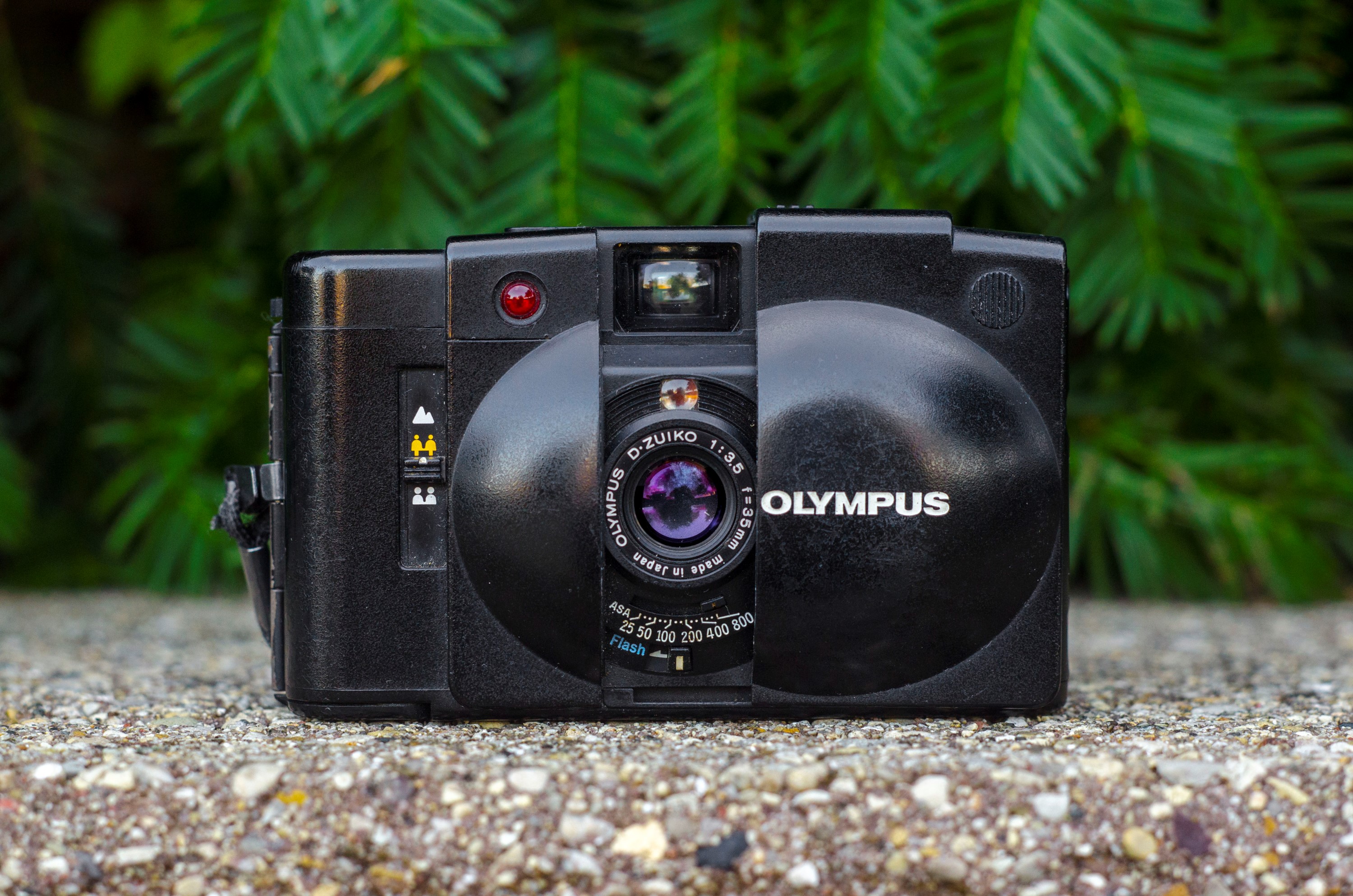
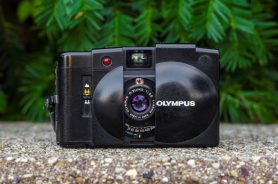
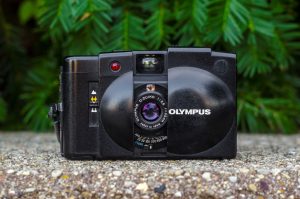








Great review!
Great review. I really like my (son’s) XA 2 for the combination of sharp lens and small size. But I’m still thinking about getting an XA too…
Very nice write up Mike! Thanks for taking the time to have a look at this fun little camera.
I have had 2 XA’s and sold them both. I could not get on with the tiny focus throw or the very feint rangefinder patch. I still have an XA2 which I prefer for this type of photography. If I really want to select my aperture I will use one of my other cameras.
Thanks for the great words! I recently picked up an XA2, has some light leaks but that’s fixable!
The tips on the close focus mode is very useful!
Yowsuhroonies. Those quoted prices, like all compacts these days, did NOT hold up very long. 🙂